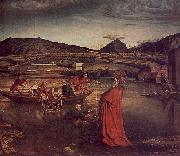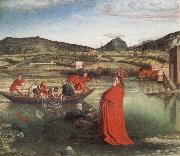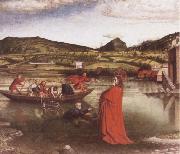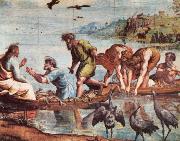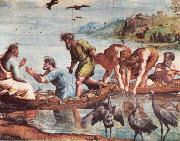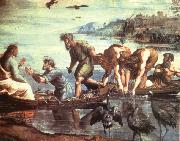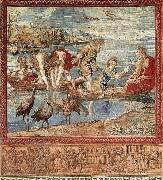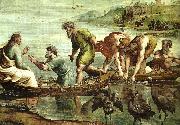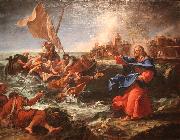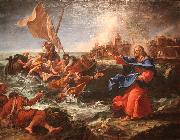Wholesale Oil Painting No Minimum |
|||||||||||
|
|
|||||||||||

|
|||||||||||
|
|
|
||||||||
Conrad Witz1400-1446 German (Resident in Switzerland) Conrad Witz Gallery -6). German painter. One of the great innovators in northern European painting, he turned away from the lyricism of the preceding generation of German painters. His sturdy, monumental figures give a strong impression of their physical presence, gestures are dignified and the colours strong and simple. Even scenes with several figures are strangely undramatic and static. The surface appearance of materials, especially metals and stone, is intensely observed and recorded with an almost naive precision. Powerful cast shadows help to define the spatial relationships between objects. His fresh approach to the natural world reflects that of the Netherlandish painters: the Master of Fl?malle and the van Eycks. He need not, however, have trained in the Netherlands or in Burgundy as knowledge of their style could have been gained in Basle. He remained, however, untouched by the anecdotal quality present in their art, while Witz pure tempera technique differs emphatically from the refined use of oil glazes that endows Netherlandish pictures with their jewel-like brilliance. |
||||||||
|
|
||||||||
The Miraculous Draught of Fishes
The Miraculous Draught of Fishes Painting ID:: 646 |
1444 1444 |
|||||||
|
|
||||||||
WITZ, Konradb. cca 1400, Rottweil, d. ca. 1445, Basel. German-born painter from Rottweil in Swabia, active in Switzerland. German painter. One of the great innovators in northern European painting, he turned away from the lyricism of the preceding generation of German painters. His sturdy, monumental figures give a strong impression of their physical presence, gestures are dignified and the colours strong and simple. Even scenes with several figures are strangely undramatic and static. The surface appearance of materials, especially metals and stone, is intensely observed and recorded with an almost naive precision. Powerful cast shadows help to define the spatial relationships between objects. His fresh approach to the natural world reflects that of the Netherlandish painters: the Master of Fl?malle and the van Eycks. He need not, however, have trained in the Netherlands or in Burgundy as knowledge of their style could have been gained in Basle. He remained, however, untouched by the anecdotal quality present in their art, |
||||||||
|
|
||||||||
|
|
The Miraculous Draught of Fishes
The Miraculous Draught of Fishes Painting ID:: 33449 |
mk86
1444
Tempera on wood
132x154cm
Geneva.
mk86 1444 Tempera on wood 132x154cm Geneva. |
||||||
|
|
||||||||
WITZ, Konradb. cca 1400, Rottweil, d. ca. 1445, Basel. German-born painter from Rottweil in Swabia, active in Switzerland. German painter. One of the great innovators in northern European painting, he turned away from the lyricism of the preceding generation of German painters. His sturdy, monumental figures give a strong impression of their physical presence, gestures are dignified and the colours strong and simple. Even scenes with several figures are strangely undramatic and static. The surface appearance of materials, especially metals and stone, is intensely observed and recorded with an almost naive precision. Powerful cast shadows help to define the spatial relationships between objects. His fresh approach to the natural world reflects that of the Netherlandish painters: the Master of Fl?malle and the van Eycks. He need not, however, have trained in the Netherlands or in Burgundy as knowledge of their style could have been gained in Basle. He remained, however, untouched by the anecdotal quality present in their art, |
||||||||
|
|
||||||||
|
|
The Miraculous Draught of Fishes
The Miraculous Draught of Fishes Painting ID:: 40191 |
mk156
1444
Oil on panel
129x155cm
mk156 1444 Oil on panel 129x155cm |
||||||
|
|
||||||||
RaphaelItalian High Renaissance Painter, 1483-1520 Raphael Sanzio, usually known by his first name alone (in Italian Raffaello) (April 6 or March 28, 1483 ?C April 6, 1520), was an Italian painter and architect of the High Renaissance, celebrated for the perfection and grace of his paintings and drawings. Together with Michelangelo and Leonardo da Vinci, he forms the traditional trinity of great masters of that period. Raphael was enormously productive, running an unusually large workshop, and, despite his early death at thirty-seven, a large body of his work remains, especially in the Vatican, whose frescoed Raphael Rooms were the central, and the largest, work of his career, although unfinished at his death. After his early years in Rome, much of his work was designed by him and executed largely by the workshop from his drawings, with considerable loss of quality. He was extremely influential in his lifetime, though outside Rome his work was mostly known from his collaborative printmaking. After his death, the influence of his great rival Michelangelo was more widespread until the 18th and 19th centuries, when Raphael's more serene and harmonious qualities were again regarded as the highest models. His career falls naturally into three phases and three styles, first described by Giorgio Vasari: his early years in Umbria, then a period of about four years (from 1504-1508) absorbing the artistic traditions of Florence, followed by his last hectic and triumphant twelve years in Rome, working for two Popes and their close associates. |
||||||||
|
|
||||||||
|
|
The Miraculous Draught of fishes
The Miraculous Draught of fishes Painting ID:: 50891 |
mk216
it's a miracle tha Raphael's seven tapestry cartoons survive for they are paintd in warter-colour on a fragile jig-saw of paper piecces glued together.
mk216 it's a miracle tha Raphael's seven tapestry cartoons survive for they are paintd in warter-colour on a fragile jig-saw of paper piecces glued together. |
||||||
|
|
||||||||
|
|
||||||||
|
|
The Miraculous Draught of fishes
The Miraculous Draught of fishes Painting ID:: 52748 |
mk223
oil on canvas
mk223 oil on canvas |
||||||
|
|
||||||||
RaphaelItalian High Renaissance Painter, 1483-1520 Raphael Sanzio, usually known by his first name alone (in Italian Raffaello) (April 6 or March 28, 1483 ?C April 6, 1520), was an Italian painter and architect of the High Renaissance, celebrated for the perfection and grace of his paintings and drawings. Together with Michelangelo and Leonardo da Vinci, he forms the traditional trinity of great masters of that period. Raphael was enormously productive, running an unusually large workshop, and, despite his early death at thirty-seven, a large body of his work remains, especially in the Vatican, whose frescoed Raphael Rooms were the central, and the largest, work of his career, although unfinished at his death. After his early years in Rome, much of his work was designed by him and executed largely by the workshop from his drawings, with considerable loss of quality. He was extremely influential in his lifetime, though outside Rome his work was mostly known from his collaborative printmaking. After his death, the influence of his great rival Michelangelo was more widespread until the 18th and 19th centuries, when Raphael's more serene and harmonious qualities were again regarded as the highest models. His career falls naturally into three phases and three styles, first described by Giorgio Vasari: his early years in Umbria, then a period of about four years (from 1504-1508) absorbing the artistic traditions of Florence, followed by his last hectic and triumphant twelve years in Rome, working for two Popes and their close associates. |
||||||||
|
|
||||||||
|
|
The Miraculous Draught of Fishes
The Miraculous Draught of Fishes Painting ID:: 53415 |
mk231
1515
Oil on paper
mk231 1515 Oil on paper |
||||||
|
|
||||||||
RAFFAELLO SanzioItalian High Renaissance Painter, 1483-1520 Italian painter and architect. As a member of Perugino's workshop, he established his mastery by 17 and began receiving important commissions. In 1504 he moved to Florence, where he executed many of his famous Madonnas; his unity of composition and suppression of inessentials is evident in The Madonna of the Goldfinch (c. 1506). Though influenced by Leonardo da Vinci's chiaroscuro and sfumato, his figure types were his own creation, with round, gentle faces that reveal human sentiments raised to a sublime serenity. In 1508 he was summoned to Rome to decorate a suite of papal chambers in the Vatican. The frescoes in the Stanza della Segnatura are probably his greatest work; the most famous, The School of Athens (1510 C 11), is a complex and magnificently ordered allegory of secular knowledge showing Greek philosophers in an architectural setting. The Madonnas he painted in Rome show him turning away from his earlier work's serenity to emphasize movement and grandeur, partly under Michelangelo's High Renaissance influence. The Sistine Madonna (1513) shows the richness of colour and new boldness of compositional invention typical of his Roman period. He became the most important portraitist in Rome, designed 10 large tapestries to hang in the Sistine Chapel, designed a church and a chapel, assumed the direction of work on St. Peter's Basilica at the death of Donato Bramante, |
||||||||
|
|
||||||||
|
|
The Miraculous Draught of Fishes
The Miraculous Draught of Fishes Painting ID:: 63776 |
1519 Tapestry in silk and wool, with silver-gilt threads, height 490 cm, width 441 cm Musei Vaticani, Vatican The tapestry was made by Pieter van Aelst, after a cartoon by Raphael Sanzio. Luke (5:1-11) recounts how Jesus, sitting in a boat, began teaching the multitudes on the shore. Then he asked Simon Peter to head towards deep water and cast the fishing nets again. Peter obeyed and they caught such a large amount of fish, that the nets began to break. They called for help and they filled both boats, so that they began to sink. Simon Peter fell down at Jesus' feet, saying "Depart from me, for I am a sinful man, O Lord!". For amazement had seized him and also James, son of Zebedee, his brother John and all their companions, because of the catch of fish which they had taken. And Jesus said to Simon "Do not fear, from now on you will be catching men." In the background, one can recognize the Vatican hill, with the towers along the wall of Leo IV, and Saint Peter's under construction. The cranes in the foreground, symbols of vigilance, are contrasted with the seagulls that allude to sin and apostasy. In the lower border two episodes in the life of Giovanni de'Medici (Pope Leo X) are depicted: on the left, his retinue, as he arrives in Rome for the conclave. On the right, the election of March 11, 1513. The border simulates a relief and is executed in chiaroscuro. Raphael's designs revolutionized the tradition of tapestry weaving, for they required a faithful rendering of atmosphere, light, textures, and pictorial form that had never been seen in this medium before. Here, for the first time, the usual monochrome background, or one depicting flowers and small ornaments, was abandoned in favour of a genuine pictorial space, in which the figures could move about.Artist:RAFFAELLO Sanzio Title: The Miraculous Draught of Fishes Painted in 1501-1550 , Italian - - graphics : religious 1519 Tapestry in silk and wool, with silver-gilt threads, height 490 cm, width 441 cm Musei Vaticani, Vatican The tapestry was made by Pieter van Aelst, after a cartoon by Raphael Sanzio. Luke (5:1-11) recounts how Jesus, sitting in a boat, began teaching the multitudes on the shore. Then he asked Simon Peter to head towards deep water and cast the fishing nets again. Peter obeyed and they caught such a large amount of fish, that the nets began to break. They called for help and they filled both boats, so that they began to sink. Simon Peter fell down at Jesus' feet, saying "Depart from me, for I am a sinful man, O Lord!". For amazement had seized him and also James, son of Zebedee, his brother John and all their companions, because of the catch of fish which they had taken. And Jesus said to Simon "Do not fear, from now on you will be catching men." In the background, one can recognize the Vatican hill, with the towers along the wall of Leo IV, and Saint Peter's under construction. The cranes in the foreground, symbols of vigilance, are contrasted with the seagulls that allude to sin and apostasy. In the lower border two episodes in the life of Giovanni de'Medici (Pope Leo X) are depicted: on the left, his retinue, as he arrives in Rome for the conclave. On the right, the election of March 11, 1513. The border simulates a relief and is executed in chiaroscuro. Raphael's designs revolutionized the tradition of tapestry weaving, for they required a faithful rendering of atmosphere, light, textures, and pictorial form that had never been seen in this medium before. Here, for the first time, the usual monochrome background, or one depicting flowers and small ornaments, was abandoned in favour of a genuine pictorial space, in which the figures could move about.Artist:RAFFAELLO Sanzio Title: The Miraculous Draught of Fishes Painted in 1501-1550 , Italian - - graphics : religious |
||||||
|
|
||||||||
RaphaelItalian High Renaissance Painter, 1483-1520 Raphael Sanzio, usually known by his first name alone (in Italian Raffaello) (April 6 or March 28, 1483 ?C April 6, 1520), was an Italian painter and architect of the High Renaissance, celebrated for the perfection and grace of his paintings and drawings. Together with Michelangelo and Leonardo da Vinci, he forms the traditional trinity of great masters of that period. Raphael was enormously productive, running an unusually large workshop, and, despite his early death at thirty-seven, a large body of his work remains, especially in the Vatican, whose frescoed Raphael Rooms were the central, and the largest, work of his career, although unfinished at his death. After his early years in Rome, much of his work was designed by him and executed largely by the workshop from his drawings, with considerable loss of quality. He was extremely influential in his lifetime, though outside Rome his work was mostly known from his collaborative printmaking. After his death, the influence of his great rival Michelangelo was more widespread until the 18th and 19th centuries, when Raphael's more serene and harmonious qualities were again regarded as the highest models. His career falls naturally into three phases and three styles, first described by Giorgio Vasari: his early years in Umbria, then a period of about four years (from 1504-1508) absorbing the artistic traditions of Florence, followed by his last hectic and triumphant twelve years in Rome, working for two Popes and their close associates. |
||||||||
|
|
||||||||
|
|
the miraculous draught of fishes
the miraculous draught of fishes Painting ID:: 64822 |
her majesty the queen, on loan to the vitoria and albert museum.
bobdy colour on paper, 320x390cm
se her majesty the queen, on loan to the vitoria and albert museum. bobdy colour on paper, 320x390cm se |
||||||
|
|
||||||||
Sebastiano Ricci(1 August 1659 - 15 May 1734) was an Italian painter of the late Baroque school of Venice. About the same age as Piazzetta, and an elder contemporary of Tiepolo, he represents a late version of the vigorous and luminous Cortonesque style of grand manner fresco painting. He was born in Belluno, son of Andreana and Livio Ricci. In 1671, he apprenticed to Federico Cerebri of Venice. Others claim Ricci's first master was Sebastiano Mazzoni. In 1678, a youthful indiscretion led to an unwanted pregnancy, and ultimately to a greater scandal, when Ricci was accused of attempting to poison the young pregnant woman to avoid marriage. Imprisoned, he gained release only after intervention of a nobleman, probably a Pisani family member. He married the pregnant mother in 1691, although this was a stormy union. After his arrest, he moved to Bologna, where he domiciled near the Parish of San Michele del Mercato. His painting style there was apparently influenced by Giovanni Gioseffo dal Sole. On 28 September 1682 he was contracted by the "Fraternity of Saint John of Florence" to paint a Decapitation of John the Baptist for their Oratory. On 9 December 1685, the Count of San Segundo near Parma commissioned from Ricci the decoration of the Oratory of the Madonna of the Seraglio, which he completed in collaboration of Ferdinando Galli-Bibiena by October 1687, receiving a compensation of 4,482 Lira. |
||||||||
|
|
||||||||
|
|
The Miraculous Draught of Fishes
The Miraculous Draught of Fishes Painting ID:: 86668 |
circa 1695-1697, oil on canvas.1695
cjr circa 1695-1697, oil on canvas.1695 cjr |
||||||
|
|
||||||||
Sebastiano Ricci(1 August 1659 - 15 May 1734) was an Italian painter of the late Baroque school of Venice. About the same age as Piazzetta, and an elder contemporary of Tiepolo, he represents a late version of the vigorous and luminous Cortonesque style of grand manner fresco painting. He was born in Belluno, son of Andreana and Livio Ricci. In 1671, he apprenticed to Federico Cerebri of Venice. Others claim Ricci's first master was Sebastiano Mazzoni. In 1678, a youthful indiscretion led to an unwanted pregnancy, and ultimately to a greater scandal, when Ricci was accused of attempting to poison the young pregnant woman to avoid marriage. Imprisoned, he gained release only after intervention of a nobleman, probably a Pisani family member. He married the pregnant mother in 1691, although this was a stormy union. After his arrest, he moved to Bologna, where he domiciled near the Parish of San Michele del Mercato. His painting style there was apparently influenced by Giovanni Gioseffo dal Sole. On 28 September 1682 he was contracted by the "Fraternity of Saint John of Florence" to paint a Decapitation of John the Baptist for their Oratory. On 9 December 1685, the Count of San Segundo near Parma commissioned from Ricci the decoration of the Oratory of the Madonna of the Seraglio, which he completed in collaboration of Ferdinando Galli-Bibiena by October 1687, receiving a compensation of 4,482 Lira. |
||||||||
|
|
||||||||
|
|
The Miraculous Draught of Fishes
The Miraculous Draught of Fishes Painting ID:: 91456 |
1695(1695)
Source Detroit Institute of Arts
cyf 1695(1695) Source Detroit Institute of Arts cyf |
||||||
|
|
||||||||
|
Sebastiano Ricci (1 August 1659 - 15 May 1734) was an Italian painter of the late Baroque school of Venice. About the same age as Piazzetta, and an elder contemporary of Tiepolo, he represents a late version of the vigorous and luminous Cortonesque style of grand manner fresco painting. He was born in Belluno, son of Andreana and Livio Ricci. In 1671, he apprenticed to Federico Cerebri of Venice. Others claim Ricci's first master was Sebastiano Mazzoni. In 1678, a youthful indiscretion led to an unwanted pregnancy, and ultimately to a greater scandal, when Ricci was accused of attempting to poison the young pregnant woman to avoid marriage. Imprisoned, he gained release only after intervention of a nobleman, probably a Pisani family member. He married the pregnant mother in 1691, although this was a stormy union. After his arrest, he moved to Bologna, where he domiciled near the Parish of San Michele del Mercato. His painting style there was apparently influenced by Giovanni Gioseffo dal Sole. On 28 September 1682 he was contracted by the "Fraternity of Saint John of Florence" to paint a Decapitation of John the Baptist for their Oratory. On 9 December 1685, the Count of San Segundo near Parma commissioned from Ricci the decoration of the Oratory of the Madonna of the Seraglio, which he completed in collaboration of Ferdinando Galli-Bibiena by October 1687, receiving a compensation of 4,482 Lira. The Miraculous Draught of Fishes 1695(1695) Source Detroit Institute of Arts cyf |
||||||||
|
|
||||||||
|
Prev Next
|
||||||||
|
|
||||||||
|
Related Paintings to Sebastiano Ricci :. |
||||||||
|
|
||||||||
|
CONTACT US |
